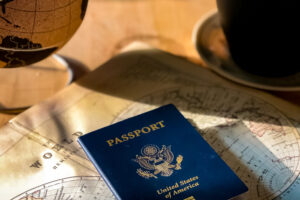Leaving the country huh? Super exciting! Maybe it’s your first time? Maybe it’s not. Or maybe you haven’t ever had to think about the logistics on your own before.
It can be overwhelming leading up to a big trip. Trying to remember all the things you should do before you go is nerve-wracking. I get you. I often drive myself (and my husband) crazy with my flurry of pre-trip activity.
So to help you (and myself!) out, I’ve put together a little list of important things to do before hittin’ the road – to ensure everything goes smoothly.
1. Check your passport
So…if you’re leaving the country, you have a passport, right? If you don’t, that’s kind of a big problem. You need to get one pronto. Check out this post for some guidance.
If you DO already have a passport, at least two months before your trip, whip that puppy out. This is for two reasons:
- To make sure you know where it is. Believe me, I’ve put many things in a “special place” as to not lose them – and then promptly forgotten where that “special place” is.
- To check when your passport expires. If it is already expired, get on renewing it ASAP. If it expires within 6 months of your departure date, you may need to go ahead and renew it also. Some countries will not allow you to enter if your passport expires within 6 months of your date of travel. It’s important to check this way ahead of time, so you have time to get it renewed without having to pay for expedited service.

2. Apply for a visa (if needed)
Double check to see if you need a visa to travel to your destination. A valid US passport allows you to travel to 116 countries around the word visa-free – but that doesn’t mean everywhere. Use the US State Department’s destination page to look up your destination country’s visa requirements.
 3. Obtain an International Driver’s Permit
3. Obtain an International Driver’s Permit
Going to be driving in a foreign country? You may need to obtain an International Driver’s Permit (IDP). Many countries strongly recommend them (check the list on the IDP application). An IDP is easy to get from AAA, and basically just translates your identification into 10 different languages. It also serves as a valid form of ID in most countries. It is inexpensive (around $20), easy to get, and saves you fines should you be stopped without one.
4. Make copies
Make a few paper copies of your passport and IDP before leaving the country. Leave one at home or with a family member. Take the others with you, but pack them separately from your actual passport. If your passport gets lost or stolen abroad, you will have an easier go of getting a replacement with copies. You could also take a photo of your passport on your phone and email it you yourself. That way, if you lose the paper copy, you can retrieve it easily with an internet connection.
5. Check alerts & register your trip
 These days you just never know what might happen in the world. So it’s good to be aware of potentially dangerous situations and political unrest before leaving the country. While you’re on the US State Department’s website, you can check any for any travel advisories or alerts regarding your destination country. You can also use this site to find out passport validity and vaccination requirements.
These days you just never know what might happen in the world. So it’s good to be aware of potentially dangerous situations and political unrest before leaving the country. While you’re on the US State Department’s website, you can check any for any travel advisories or alerts regarding your destination country. You can also use this site to find out passport validity and vaccination requirements.
To ensure you stay up to date with alerts, you can register your trip with the Smart Traveler Enrollment Program (STEP). This free service will send you alerts (via email or text) from the US embassy should something arise in your destination country. It is good to do this BEFORE your trip, so you’re up to date on any alerts leading up to your departure.
6. Get vaccinated & have medications in order
Check the CDC’s Travelers’ Health site to see if there are any vaccine requirements/ recommendations for your destination country. You should be fine if you are traveling to Europe or other well-developed places. But its good to check!
It’s also important to get all of your medications in order (if you’re taking prescription meds). Be sure to have enough on hand for your trip, and a couple extra days – just in case. Since I have an auto-immune disease, I take many prescription medications. I keep them all organized in this handy pill case. It’s compact, and has extra pockets where I can store a list of medications and dosage amounts (so I do not have to carry the original bottles). It also fits neatly in my carry on baggage. ALWAYS carry your prescription medication with you. You would be totally screwed if you packed it in your checked luggage, and your bag got lost.
7. Notify your bank
Unless you’re traveling with your sugar mama/daddy who’s footing the bill, you’re gonna need a plan for accessing your money while abroad. Two weeks or less before you depart, you’ll need to notify your bank and your credit cards of your travel plans.
Many banks closely monitor their accounts. Any suspicious activity (such as a random charge in Paris out of the blue) will get flagged as fraudulent activity. And the bank would shut that shit down fast to prevent further loss. Then you’d be stuck in a foreign country with no access to your bank funds – and tasked with the hassle of calling the bank and to get it sorted out. This is easily avoidable simply by calling the bank ahead of time.
While you have them on the phone:
- Inform them of ALL the potential countries you will be visiting during your trip – including layover countries. This ensures that the random waffle you bought during your 1-hour layover in Brussels doesn’t shut your card off.
- Ask them if they have any affiliate banks in the countries you are visiting. Some banks have partners overseas which allow you to withdrawal money at ATMs without a fee. This is super helpful.
- Check to see if there are any foreign transaction fees associated with using your card overseas. Some credit and debit cards do not charge fees, others typically charge you 1-3% per transaction. In this instance, it makes more sense to use your card sparingly, and carry cash. The cheapest way to get cash overseas is to withdrawal it in local currency from an ATM after you land. AVOID currency exchange counters at the airport like the plague, they are a total and utter rip off.

8. Prepare your wallet
In my opinion, it’s important to pare down your wallet. For the love of God, don’t bring your regular, bulging, over-stuffed wallet with you overseas. Only bring the credit or debit cards you intend to use and your ID. Done.
Don’t bring eeeeeeverything. Like your SSN card, store reward cards, gift cards and all the other shit we carry around in our wallets. I have a different (cheapo) wallet that I bring, which I just put the travel basics in. Downsizing will save you the headache of having to replace everything in your wallet should it happen to get lost or stolen on your vacation.
9. Have a plan for staying connected
Chances are, your phone will work abroad. However, international roaming charges are a bitch. It’s best to have a plan in place to avoid them. Most major US cell phone companies offer some sort of temporary international plan for calling, text and data abroad. Check out the major US carrier’s international options here:
10. Prepare your phone
Even if you have an international plan in place, it’s best to avoid using up too much data. Turn off cellular data for apps that you don’t specifically plan on using. So they don’t eat up data in the background. On iOS go to Settings>Cellular and scroll down to turn off data to specific apps.
If you DON’T plan on purchasing an international plan on your phone, be careful. You don’t want to accidentally connect to a foreign service using cellular roaming. You’ll end up with a nasty surprise bill when you get home. Your best bet is to keep your phone in airplane mode the whole time, and only use it when connected to wifi.
When using this method, be sure to prepare for being offline most of the time. Take screen shots of important reservation and flight info, and download maps from Google Maps or Maps.me to be used offline.
11. Stay charged up

Hong Kong, where my hair straightener bit the dust. 🙁
Voltages and plugs are different in other countries. Click here to check what they are in your destination country. It’s important to prepare ahead of time and have the appropriate plug and voltage adapters to keep your electronics charged up.
Most mobile phones are capable of being charged in a standard US socket (110 volts) as well as foreign sockets (220/230 volts) with just a plug adapter. But be sure to double check other appliances that may require a voltage adapter. It is usually stamped on the chord, or on the tag somewhere. If you can’t find it, Google it. I fried an expensive hair straightener in Hong Kong because I didn’t check….I was super bummed about that one!
Get super excited because you’re leaving the country for an amazing trip!
Hopefully this didn’t seem toooooo overwhelming. You’re still super stoked about your vacation right?!?! Got any other important pre-trip tips that I forgot to mention? Feel free to share in the comments below. 🙂






